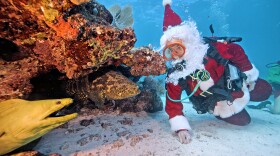A new report from The Everglades Foundation found the River of Grass will generate more than $1 trillion for Florida’s economy during the next half-century.
The billions of dollars The Everglades Foundation says are created by the River of Grass every year are not from finding gold and precious stones in the ground. It’s not the collective wealth of the airboat tour sector.
The big money is in the combined intrinsic value of things like clean water to drink and pristine forests to hike in. It’s property values when homes sit along rivers without floating green algae, and how much monetary damage healthy mangrove forests can prevent during a hurricane.
“This report delivers clear, quantified evidence on how the health of the Everglades is directly tied to America’s economic well-being,” said Paul Hindsley, chief economist at The Everglades Foundation and an author of the study. “Restoring this national treasure secures economic prosperity today and safeguards its benefits for generations to come.”
The Everglades Foundation has been a leading force in the restoration and protection of the Everglades ecosystem for years.
First it was under assault by wealthy U.S. industrialists hoping to “tame” the River of Grass by digging huge canals to drain away the water to sell home lots and agricultural spaces. Later, mom-and-pop farmers and huge industries hardly knew better when they spread phosphorus and nitrogen on crops ringing the lake, which eventually spilled into the water and hasn't gone away.
Today, many nonprofits have joined the foundation to protect what is left of the Everglades now that Miami, Fort Lauderdale, Naples, and Fort Myers have been built on either side.

The foundation is big on helping to push forward the $4 billion Everglades Agricultural Area Reservoir, often called the “crown jewel” of Everglades restoration. That aims to restore the natural flow of water, reduce harmful discharges, and secure clean drinking water for millions of Floridians.
Unveiled during the America’s Everglades Summit in Washington, D.C., the report highlights the Everglades’ $31.5 billion annual contribution to the economy through ecosystem services that include enhancing real estate, which adds $9.2 billion, recreation at $8.5 billion, and protection from hurricanes and big storms totaling $8.4 billion.
“This (report) includes topics that are central to South Floridians,” Hindsley said. “Like their real estate, tourism and recreation, their quality of life, and the critical natural infrastructure, which includes the delivery of water and reducing the impacts of storms, which impact us almost every year at some point in the state.”
The report is the product of Hindsley in collaboration with Earth Economics.
That’s a Tacoma, Washington-based nonprofit with a solid reputation for calculating and explaining the dollar value of nature’s benefits.
“The Everglades is an invaluable natural asset, improving the quality of life for residents and visitors to South Florida,” said Maya Kocian, Executive Director of Earth Economics. “This report lays a foundation for articulating the Everglades’ importance to the region’s economy and the continued need for restoration for resilience. An investment in nature is an investment in Floridians and Florida’s economy.”
Environmental reporting for WGCU is funded in part by Volo Foundation, a non-profit with a mission to accelerate change and global impact by supporting science-based climate solutions, enhancing education, and improving health.
Sign up for WGCU's monthly environmental newsletter, the Green Flash, today.
WGCU is your trusted source for news and information in Southwest Florida. We are a nonprofit public service, and your support is more critical than ever. Keep public media strong and donate now. Thank you.








